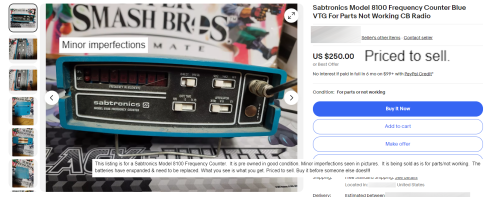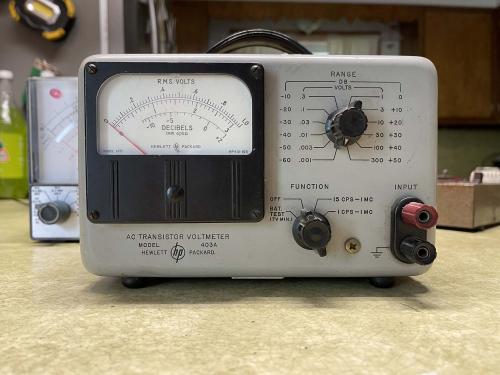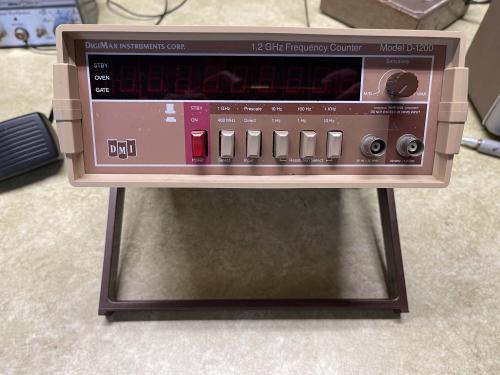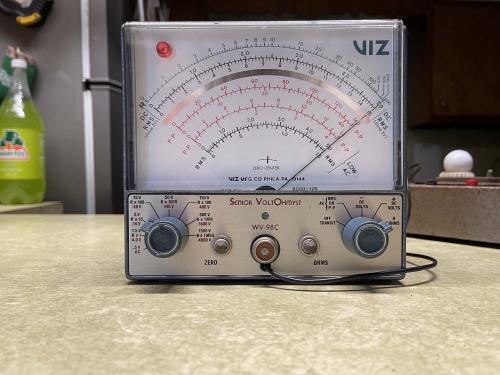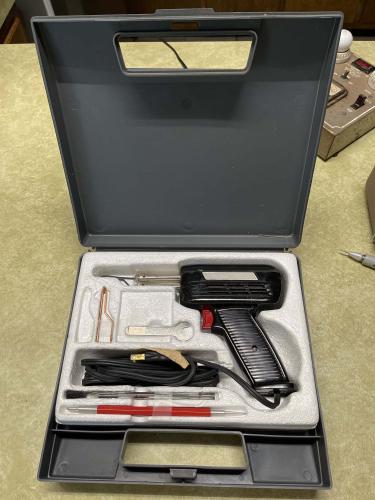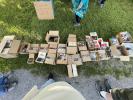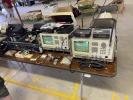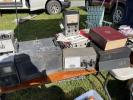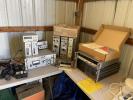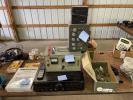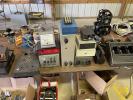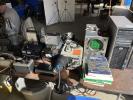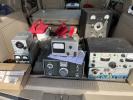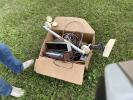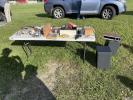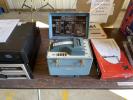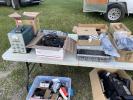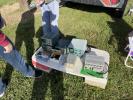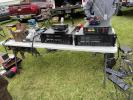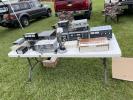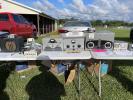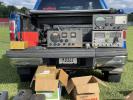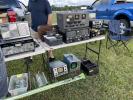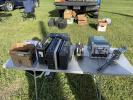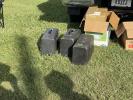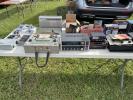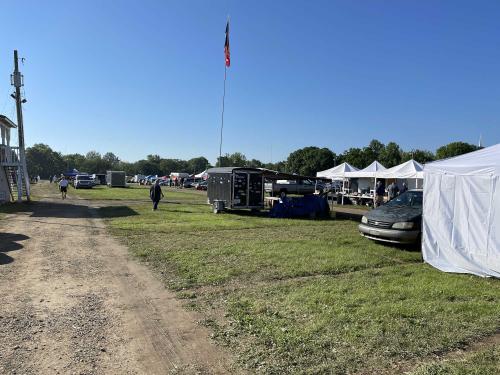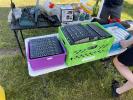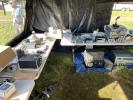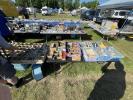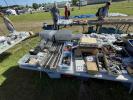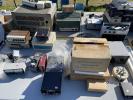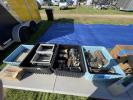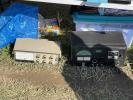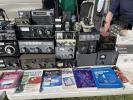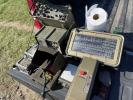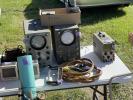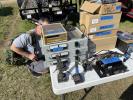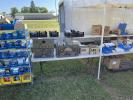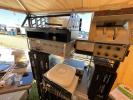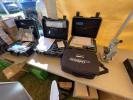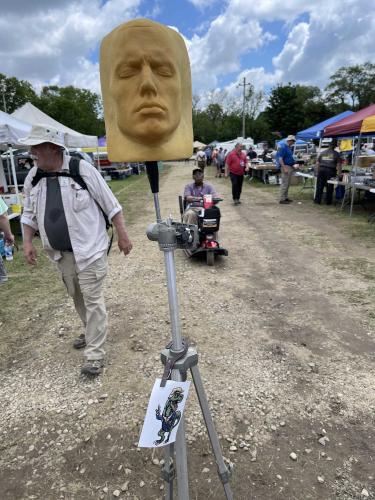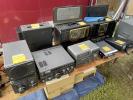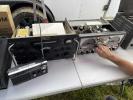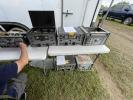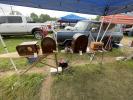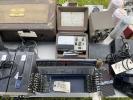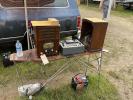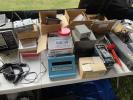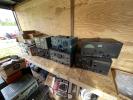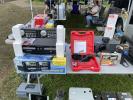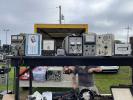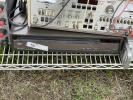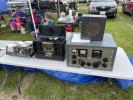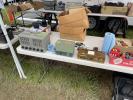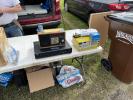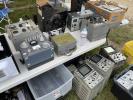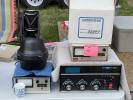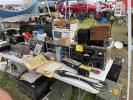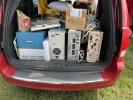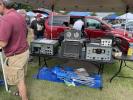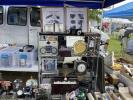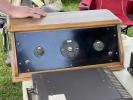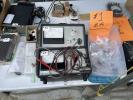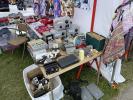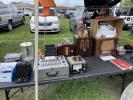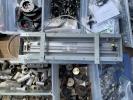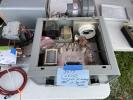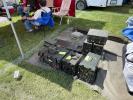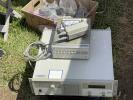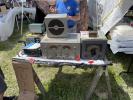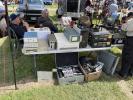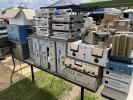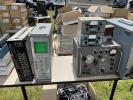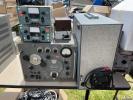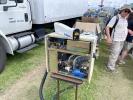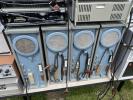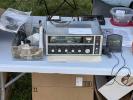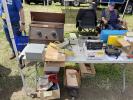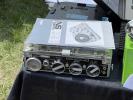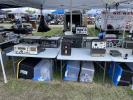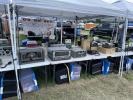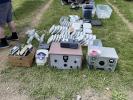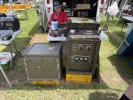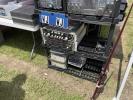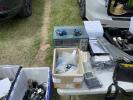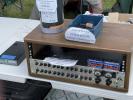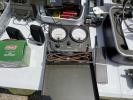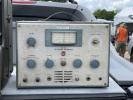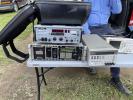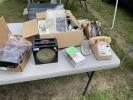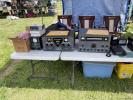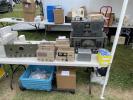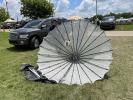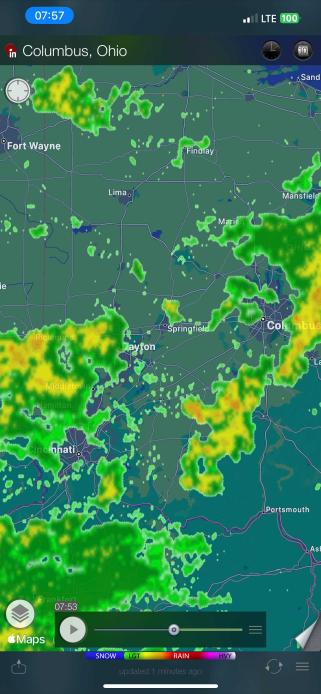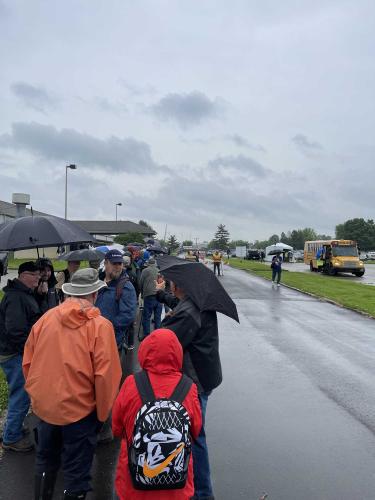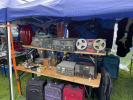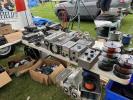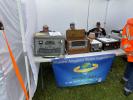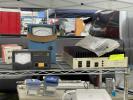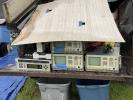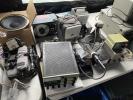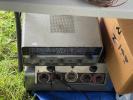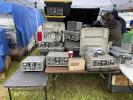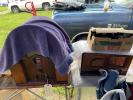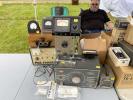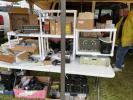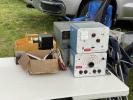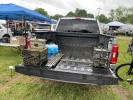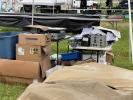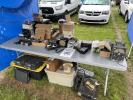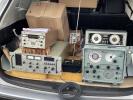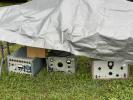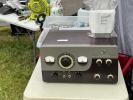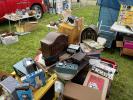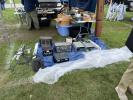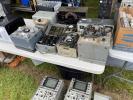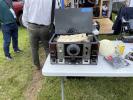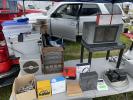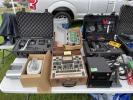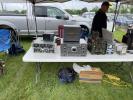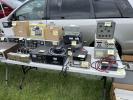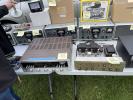- 2024
- Jun
- 13
Minor imperfections. Priced to sell.
I picked one of these guys up at Dayton for $20, modified to work in the 2M band. Figured, hey! I’ll pick up some parts units.
For some reason, a non-working device with a (hopefully intact) broken display cover, swollen batteries (and quite possibly corroded inside,) no battery cover, no (oddball) power adapter, and covered with dirt for $250 doesn’t inspire me to add “Priced to sell” in the description. Especially when the device has been superseded many times over with modern equipment at lower prices.
At least it’s free shipping!
- 2024
- Jun
- 12
pygg.xyz, the former home for this blog, is nearing it’s end.
Hosting for pygg.xyz, as well as email and SSL services, have expired. I’ve set permanent redirects so that any pygg.xyz link should send you to the wereboar.com page of the same name if it exists, or the top level of Projects if you’ve not asked for anything special. There may be a couple of (very old) broken links, but those will take you to the blog’s 404 page with information on how to find what you want to see.
Those redirects may not always work, I’m investigating that but I don’t see any immediate resolution.
You can go to the top level of Projects to see the newest stuff, or you can go to the popular posts page to see everything on Projects from the Bottom Drawer.
I used to host this blog on pygg.xyz, but rapidly found out that .xyz domains have little trust in the Internet world. This affected both my ability to present things to you, and send email reliably using that domain.
Last year, I decided to see what was available - and for some reason, wereboar.com - a very old domain - was available. The former owners, a web design shop and later, some sort of graphics design shop, had let it go. I picked it up and moved everything here, because who doesn’t like lycanthropes? It’s been much easier to get email through secured systems with a .com domain, so here I stay.
My original domain, pygg.xyz, has been live all this time, but was a simple redirect to here. However, the end is nigh and the hosting for the domain ends on July 4th, 2024. The domain is still there and good for another 7 or so years, but the hosting will be gone.
Right now, there’s a parking page indicating that it’s 410, and to come here instead.
If you have any pygg.xyz bookmarks, now is the time to move them. Most should still work if you change pygg.xyz to wereboar.com, but if you can’t find what you need then check the popular posts or sitemap, available from the main blog page.
It will probably redirect here again, but I’m not sure what I want to do with it. It’s for sale, if you are interested, and it’s pretty cheap. Contact me with the LinkedIn links on the main wereboar landing page.
Until then, it will at least resolve to something. Where does the future lie? Who knows, but I’m sure it’s full of strange electronics and oddball projects.
I hope you’ll come along for the journey.

- 2024
- Jun
- 9
Breezeshooters 2024 - What I brought home.
I tried to limit myself to things I could possibly use, and I (mostly) did so. We’ll see if all these things actually work, or if some of them need some work.
This HP AC Transistor Voltmeter Model 403A seems to be in good condition, and has a Westinghouse tag on the back. I can’t really test it because it has some odd battery requirements. It looks to need 5 mercury cell batteries - 2 4V batteries, and 3 1.35V batteries in a configuration that provides bias and + / - voltages. These are unobtainable, so a small supply may be in order if I actually want to use this thing.
This came from a vendor that had boxes of parts. One part was $2, if you took the whole box it was $1. So…I took a box of mica capacitors and some other parts. High voltage mica caps can always come in handy.
This DigiMax Instruments D-1200 counter claims to go to 1.2GHz, and has lamps for an ovenized reference on it. It’s awfully light, but it does light up. I need to get a signal in it to see if it’s actually counting, or if it’s just spitting out garbage.
The Harris-Dracon butt sett was picked up becaue it was cool looking. I don’t know what I’ll use it for, but whatever. The Waage All-Purpose Tester Model 066 test box was a dollar - it’s mostly just an ammeter you can switch out, with a fuse and a lamp for testing the AC line. It’s pretty rusty, but looks clean inside. Who knows where this will end up.
This VIZ Senior VoltOhmist WV-98C meter seems to be operational, and has a case you could kill a poodle with. It’s a two-tube unit, using a 6AL5 Dual Diode and a 12AU7 amplifier. It’s small enough to go on the bench instead of the giant EICO VTVM currently there.
This Weller solder gun has all of the tools with it, and is one of the units made in the USA. I have a couple of these, they come in handy soldering chassis items.
That’s this year’s haul. I tried to limit myself to smaller items I could use, and I mostly succeeded. There were a lot of larger items that I wanted, but left there since I don’t have room for them. In all, I didn’t spend a lot and brought home some neat things.
Next show is either the Van Wert, OH show - that’s a long drive and may not be in the cards - and/or the Columbus, OH show which is a lot closer to me and much easier to attend. Either way, stay tuned for pictures from those shows, and I’ll see you there!
- 2024
- Jun
- 9
Pictures from Breezeshooters 2024 Hamfest.
It was raining where I was, and threatened rain all the way to the show - but when we arrived, the sky had cleared and it was a sunny, slightly breezey 71F. Essentially, perfect conditions for wandering the aisles. While I didn’t see some of the things I hoped would show up this year, there was still quite a bit to look at. I spent a couple hours wandering the show before heading out for some lunch.
The usual mix of equipment showed up here, and a few things managed to wander home with me. This is what I saw at this year’s show:
.
Next show will probably be the Columbus, OH hamfest, although there are some happening before that. Regardless, I’ll (maybe) see you there!
- 2024
- Jun
- 6
Don’t stay at toxic workplaces.
A recent LinkedIn post talked about a manager style the author calls the “Up your own butt” boss. You can read that post here: https://www.linkedin … edium=member_desktop. You may need to log in to see it.
A position I held several years ago had a direct manager that fit this bill. Everything good was “We,” everything bad was “you.” Blame would be shifted, even if he was at fault.
Shortly before I left, he stormed into a shared technician office and started berating us about someone charging time - in this case, weeks - to overhead. (Overhead at this company was a charge number that you could use when you were just doing general tasks that had no direct charge. Things like setting up new equipment, cleaning an area, etc.) He was going to find out who did this, they were going to be disciplined. Possibly even fired.
He knew very well it was him doing it. He was having a house built at the time, and would go spend hours on site harassing the builders.
He should have been fired for that, as this was weeks of time he did nothing and lied about it. There were other incidents that he should have been fired for, including destroying expensive equipment from negligence.
Unfortunately, it was endemic to the entire company. His manager - the chief engineer - had a severe god complex. He was incapable of looking at something and going “Good work men, you did a great job!” Instead, he would go “I’m a great man, look at what I did.”
I learned very quickly not to go to this man with ideas, he would discount them immediately, and then implement them under his own name.
It was a terribly toxic place and almost drove me to alcoholism. I’m not proud of that, but I got out with the help of a good friend. Bless you Lance, I’d be dead if it wasn’t for you.
- 2024
- May
- 30
The Breezeshooter’s Hamfest is next weekend - June 9th 2024.
This is a great local show, and has always offered a few hours of wandering aisles and some “Dayton items without the Dayton prices.” I really need to lay off buying more boatanchors this time, but I’m sure a couple will come home with me. The club had some things they were selling last year, one piece in particular should have gone home with be - if it’s still there, it will!
(The forecast is calling for possible showers. We’ll see.)
See you there!
Breezeshooter’s Hamfest
Butler, PA
Butler Farm Show (Kind of a fairgrounds thing)
625 Evans City Rd
Butler, PA 16001
June 9 2024
8A - 2PM
https://breezeshooters.org/ns/
- 2024
- May
- 22
Finding old wereboar posts in search engines?
While I’ve submitted the site indexes to both Bing and Google, you probably have a better chance of finding something here using Bing, or those sites that use it like DuckDuckGo. For all the grief Microsoft gives us, their indexing system is quite friendly. Submit pages via their console and it goes “Sure thing! Let me index that for you.” and a few days later - there it is.
Google, on the other hand, complains. “You have a redirect! I can’t index that!” Where? It’s a static page with a link on it. There are lots of things in the index queue that were rejected and I’m not even sure where it’s getting them - it looks like it’s own temporary files are being indexed and then tossed out because they’re not there anymore. it complains about invalid pages but give no reason as to why, just that they aren’t.
Regardless, for all the crap - Bing works best if you’d like to find an old post from a search engine. Use https://www.bing.com … =site%3awereboar.com and you’ll get a pretty good list of things here on wereboar. Bing feeds other sites like DuckDuckGo and Yahoo!, so you can use those sites if Bing isn’t to your liking.
If you’d like to stay on wereboar, you can use the built-in popular post page to see an index of all the pages, and how many times they’ve been viewed. Check that out right here: https://wereboar.com … projects/popular.php
And finally, the third way you can “search” the site is to use the sitemap. This one is just a text file with all of the important URLs on wereboar. There are no titles, so this is probably not an ideal thing to use - it’s primarily so search engines can find the URLs. However, if you’d like to see it, it’s here: https://wereboar.com/about/sitemap.txt - and the auto-gen’d XML version lives here: https://wereboar.com/about/sitemap.xml.
While I can’t take suggestions here due to the large amount of spammers, please feel free to connect with and talk to me on LinkedIn: https://www.linkedin … an-walker-525b41223/ - I’d love to know what you think, and would like to know if there’s something you’d like to see more (or less!) of here on wereboar.
Thanks for checking out my place. See you soon with more goodies from shows and junk I’m working with.
- 2024
- May
- 20
Hamvention 2024 - Sunday’s Pictures.
The last day of the show was hot and dry.
Sunday was a slim day - many of the vendors pack up Saturday evening, but maybe 1/5 were still on the grounds, not counting the exhibit buildings. Lots of reduced price deals and some free stuff were around today, and I still managed to bring home too much. Today’s lunch was Bourbon Chicken and a milkshake - a bottle of sauce managed to make it home as well. In all, this was a good show even if Friday was a bit messy. It’s also the first year I didn’t go through the exhibit halls, but there’ s nothing in there I needed this year.
Here’s what I saw this year on Sunday:
.
All three days of pictures:
Friday https://wereboar.com … 24-fridays-pictures/
Saturday https://wereboar.com … -saturdays-pictures/
Sunday https://wereboar.com … 24-sundays-pictures/
Links to all the things I drug home this year:
Friday https://wereboar.com … d-in-my-car-i-swear/
Saturday https://wereboar.com … it-followed-me-home/
Sunday https://wereboar.com … t-because-its-cheap/
- 2024
- May
- 20
Hamvention 2024 - Saturday’s Pictures.
Saturday was perfect. It was about 80F, partly cloudy, and the grounds had started to dry out enough you could walk and reasonably expect to stay on the surface.
And the weird stuff came out as well…
All the vendors that toughed out the previous day were open displaying all kinds of electronic wonders. A steak tip dinner was had for lunch, and it was awesome as always - much better than the burnt burgers and nasty nachos offered by the other venue. We spent about half the day going through the flea market looking for things to take home.
Here’s what I saw this year on Saturday:
.
All three days of pictures:
Friday https://wereboar.com … 24-fridays-pictures/
Saturday https://wereboar.com … -saturdays-pictures/
Sunday https://wereboar.com … 24-sundays-pictures/
Links to all the things I drug home this year:
Friday https://wereboar.com … d-in-my-car-i-swear/
Saturday https://wereboar.com … it-followed-me-home/
Sunday https://wereboar.com … t-because-its-cheap/
- 2024
- May
- 20
Hamvention 2024 - Friday’s Pictures.
Friday promised to be a rainy day, and it wasn’t a lie. The RADAR showed rain, and lots of it!
And it was wet…
The line ride was soaked.
But that didn’t stop me from playing in the mud like a happy little wereboar. There were still plenty of vendors open with tents over their wares, and I still brought home way too much. I spent about 4 hours wandering the wet ways, and of course it decided to stop the minute I was finished! I was soaked by then, and ready to go, but Saturday and Sunday awaited.
Here’s what I saw this year on Friday:
.
All three days of pictures:
Friday https://wereboar.com … 24-fridays-pictures/
Saturday https://wereboar.com … -saturdays-pictures/
Sunday https://wereboar.com … 24-sundays-pictures/
Links to all the things I drug home this year:
Friday https://wereboar.com … d-in-my-car-i-swear/
Saturday https://wereboar.com … it-followed-me-home/
Sunday https://wereboar.com … t-because-its-cheap/
